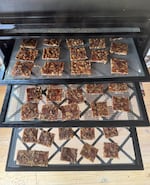
FILE- Some of the 80 different varieties of apples at Kiyokawa Family Orchard’s annual tasting event held each fall, Oct. 4, 2024. Parkdale, Ore. For those interested in learning how to preserve their own food, like dried apples, a longtime Oregon State University program provides community education.
Arya Surowidjojo / OPB
Food preservation has been a key part of sustaining human societies and cultural traditions, including in Oregon.
From indigenous practices like drying first foods to rations packed by settlers on the Oregon Trail, extending the shelf lives of foods historically combated uncertain crop supply.
These days, preserving food is popular with Oregonians as a nutritious or money-saving hobby to stockpile their pantries or to make food for camping.
Thanks to advancements in technology, food preservation has come a long way.
But some technologies are more cost-prohibitive than others. For example, a home freeze dryer can run $1,600 or more. (Did you know Oregon is a freeze-drying hub?)
For anyone looking to try do-it-yourself food safety and preservation, there’s a decades-old statewide program with an educational mission.
Meet the volunteers passionate about preservation

Don Wiley and his dog, Wasabi. Wiley has decades of experience in food preservation.
Courtesy Don Wiley

Not only does Sheryl Hall preserve food, she also keeps bees.
Courtesy Sheryl Hall
Don Wiley and Sheryl Hall are longtime Master Food Preserver Program volunteers with the Oregon State University Extension Service in Clackamas County.
Wiley and Hall have 46 years of volunteerism with the Master Food Preserver Program between them. Both train and mentor volunteers and Extension Service staff, consistently sharing their excitement and expertise about food preservation with Oregon communities.
Dehydration is a favorite practice of Wily and Hall, since it can be done year-round.
They offered OPB the following dehydration tips and tricks for beginner food preservers.
Safety first
Since dehydrating removes moisture from food, that means bacteria, yeasts and molds have less of a chance to grow and spoil food. While drying food slows down enzymes that cause decay, it doesn’t destroy or inactivate them. So, certain food safety steps need to be observed.
- Pretreatment can help ward off harmful bacteria. It also preserves color and flavor and helps make rehydration easier. Pretreatment methods include blanching and dipping in Vitamin C or lemon-treated water.
- Practice good food handling and sanitation. Clean and sanitize your work area and equipment, and rinse your food before dehydrating.
Easy methods to try
Wiley suggests using a dehydrator with a thermostat for temperature control, plus a fan and vents for air circulation and to become familiar with the appliance’s user manual. “If you don’t have a dehydrator, sometimes friends, family, or neighbors do. Some libraries’ Library of Things programs also loan out food dehydrators,” Hall said.
A dehydrator isn’t totally necessary. Other dehydrating methods can be done in microwaves, ovens or even hang drying, such as drying herbs.
Starter foods
Both Wiley and Hall point to fruits as the best entry point into dehydrating, specifically apples and bananas cut into uniform pieces.
Another way to start out with those fruits: as applesauce and pureed banana to make fruit leather.
One preservation style can transform with dehydration — canned products dry well. Beyond fruit, canned meat and fish, even chili, are easy to dehydrate and make great camping or backpacking food, the pair said.
“— Sheryl HallI often use parchment paper and have drawn a circle around zucchini slices before drying to show folks how much they shrink when they’re dry.”
“— Don WileyWhen you have too many tomatoes, slice and dehydrate them. Cut cherry tomatoes in half and dry them cup-like to hold the liquid. They’re like candy. If you have a smoker, try smoking them a bit and then dehydrate them.”
For best results
If using a dehydrator, insert a thermometer to ensure the thermostat is accurate.
Wiley and Hall said the ideal temperature for dehydrating most fruits and vegetables is 135 F. For proteins such as meat and fish, dehydrate at a minimum of 145 F. Proteins need a further step to kill potentially hazardous bacteria: 275 F for 10 minutes in a conventional oven.
After dehydrating food, check for moisture. One way is to loosely fill a jar or plastic sandwich bag with dried food and shake it up several times daily. If moisture appears, return it to the dehydrator and dry a little longer.
Store dehydrated food in a cool, dark place. Ideally, use vacuum-sealed glass jars with canning lids and rings.
“If you see mold in your product, throw the whole container away,” Hall said.

A batch of dehydrated date bars made by Sheryl Hall.
Courtesy Sheryl Hall
Level up
“To go one step further, dehydrated foods can be dried until brittle and ground into a powder,” said Hall.
Wiley offered an example: “For instance, kimchi can be dried into a powder and sprinkled on a salad or popcorn.”
Dehydrating food can be a lot of trial and error, so Hall suggests keeping notes about successes and failures. “Include the date, temperature, drying time and thickness of the product dried. Drying times will vary depending on the external humidity, temperature and moisture content of the food you’re drying.”
